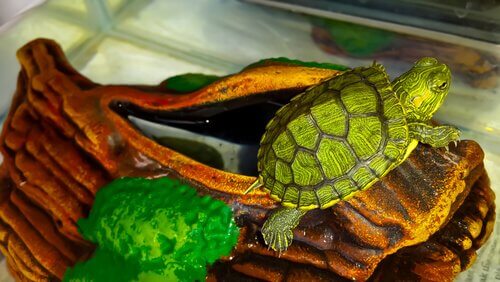What is Rhinitis in Tortoises and Turtles and How to Treat it

Tortoises and turtles (please see note at foot of article) are quite sensitive when it comes to their respiratory tracts. Because of this, it is very common, especially in aquatic species. In this article, we’ll tell you everything you need to know about rhinitis in tortoises and turtles and its treatment.
Rhinitis in tortoises and turtles: what you need to know
Rhinitis is an inflammation of the upper respiratory tract. If your turtle has it, it will have a lot of mucus in his nostrils. You might also notice noisy breathing and a loss of appetite. In addition, he might have mucus bubbles on his nose, weakness and white spots on the roof of his mouth.
Another symptom of this condition in sea turtles is that they float sideways, as if they have lost their balance. This is because one of their two lungs is not receiving enough oxygen. As a result, it is not expanding properly.
Generally, the most affected by this illness are those in the genus Testudo: Graeca, Hermanni, Icata, Pardalis, Marginata, Leprosa, Chilensis, Horsfieldii and Emys.
The bad thing about rhinitis in tortoises and turtles is that it is contagious. Therefore, you must be careful if you have more than one turtle in the same tank. A turtle’s immune system must be in excellent condition in order to deal with any viruses and bacteria entering the body.

Why do turtles get rhinitis?
There are various causes of rhinitis in tortoises and turtles, including diet, environment, bacteria, a weak immune system or viruses. In many turtles, it is even the result of the herpes virus, a very common disease among turtles. Also, it can result from pneumonia, stomatitis or septicemia.
When turtles produce excessive amounts of mucus, it may be the result of grasses or other things getting into their noses or mouths or, alternatively, of infections caused by microorganisms that are present in the water. Other factors that trigger this illness are:
- Changes in temperature (which weaken their defenses)
- Overcrowding (too many turtles in one tank)
- Stress (due to changes in their tanks, a move, the presence of other animals, overcrowding)
- Humidity (in the case of land turtles that are in contact with humid or wet places)
- Environmental pollution (a tank or shelter that is not clean enough, which leads to more fungi and bacteria)
- Different species that share one habitat (a germ that is harmless to one genus can be deadly to another
Treating rhinitis in turtles
Certainly, it is very important to take your pet to the veterinarian to perform routine exams and rule out any diseases or illnesses. In the event that you notice anything that seems out of the norm, you shouldn’t wait. The situation could get worse and become chronic.
In the case of rhinitis in turtles, it’s important to know that the turtle may not show any symptoms at the beginning. However, he can still infect others with any germs and bacteria. If the problem isn’t treated properly, it can lead to acute or chronic pneumonia.
Treatment options
There are different options to treat this condition. The veterinarian will make a culture of the mucus to test it. That way, he can know what bacterium or virus is causing it. Based on this, he will have you give the turtle mucolytic or fluidizing agents either orally or by injection. He might also prescribe antibiotics, nasal washes and disinfecting the mouth.

If the case is severe or if the turtle shares a tank with other turtles, he will recommend that the turtle be quarantined in a small room. You should keep the room at a temperature of 25 to 32°C with strong lighting.
In any case, even if he is not hungry, we must do everything possible to keep the turtle hydrated and fed. Choose foods that he likes, and leave them very close to his mouth.
Finally, some veterinarians may also recommend the use of an inhaler. This is made with an air pump for tanks, a container with the liquid the turtle needs to inhale and an outlet tube. The idea is that the turtle is in a small space. So, the container with the medication is placed underneath the grates that tend to be at the bottom of the tank.
Please note: In this article we’ve alternated between the terms turtle and tortoise, as the illness refers to both species. To know how to differentiate between them, please have a look at the following article:
https://www.britannica.com/story/whats-the-difference-between-a-turtle-and-a-tortoise
Tortoises and turtles (please see note at foot of article) are quite sensitive when it comes to their respiratory tracts. Because of this, it is very common, especially in aquatic species. In this article, we’ll tell you everything you need to know about rhinitis in tortoises and turtles and its treatment.
Rhinitis in tortoises and turtles: what you need to know
Rhinitis is an inflammation of the upper respiratory tract. If your turtle has it, it will have a lot of mucus in his nostrils. You might also notice noisy breathing and a loss of appetite. In addition, he might have mucus bubbles on his nose, weakness and white spots on the roof of his mouth.
Another symptom of this condition in sea turtles is that they float sideways, as if they have lost their balance. This is because one of their two lungs is not receiving enough oxygen. As a result, it is not expanding properly.
Generally, the most affected by this illness are those in the genus Testudo: Graeca, Hermanni, Icata, Pardalis, Marginata, Leprosa, Chilensis, Horsfieldii and Emys.
The bad thing about rhinitis in tortoises and turtles is that it is contagious. Therefore, you must be careful if you have more than one turtle in the same tank. A turtle’s immune system must be in excellent condition in order to deal with any viruses and bacteria entering the body.

Why do turtles get rhinitis?
There are various causes of rhinitis in tortoises and turtles, including diet, environment, bacteria, a weak immune system or viruses. In many turtles, it is even the result of the herpes virus, a very common disease among turtles. Also, it can result from pneumonia, stomatitis or septicemia.
When turtles produce excessive amounts of mucus, it may be the result of grasses or other things getting into their noses or mouths or, alternatively, of infections caused by microorganisms that are present in the water. Other factors that trigger this illness are:
- Changes in temperature (which weaken their defenses)
- Overcrowding (too many turtles in one tank)
- Stress (due to changes in their tanks, a move, the presence of other animals, overcrowding)
- Humidity (in the case of land turtles that are in contact with humid or wet places)
- Environmental pollution (a tank or shelter that is not clean enough, which leads to more fungi and bacteria)
- Different species that share one habitat (a germ that is harmless to one genus can be deadly to another
Treating rhinitis in turtles
Certainly, it is very important to take your pet to the veterinarian to perform routine exams and rule out any diseases or illnesses. In the event that you notice anything that seems out of the norm, you shouldn’t wait. The situation could get worse and become chronic.
In the case of rhinitis in turtles, it’s important to know that the turtle may not show any symptoms at the beginning. However, he can still infect others with any germs and bacteria. If the problem isn’t treated properly, it can lead to acute or chronic pneumonia.
Treatment options
There are different options to treat this condition. The veterinarian will make a culture of the mucus to test it. That way, he can know what bacterium or virus is causing it. Based on this, he will have you give the turtle mucolytic or fluidizing agents either orally or by injection. He might also prescribe antibiotics, nasal washes and disinfecting the mouth.

If the case is severe or if the turtle shares a tank with other turtles, he will recommend that the turtle be quarantined in a small room. You should keep the room at a temperature of 25 to 32°C with strong lighting.
In any case, even if he is not hungry, we must do everything possible to keep the turtle hydrated and fed. Choose foods that he likes, and leave them very close to his mouth.
Finally, some veterinarians may also recommend the use of an inhaler. This is made with an air pump for tanks, a container with the liquid the turtle needs to inhale and an outlet tube. The idea is that the turtle is in a small space. So, the container with the medication is placed underneath the grates that tend to be at the bottom of the tank.
Please note: In this article we’ve alternated between the terms turtle and tortoise, as the illness refers to both species. To know how to differentiate between them, please have a look at the following article:
https://www.britannica.com/story/whats-the-difference-between-a-turtle-and-a-tortoise
All cited sources were thoroughly reviewed by our team to ensure their quality, reliability, currency, and validity. The bibliography of this article was considered reliable and of academic or scientific accuracy.
- García-Párraga, D., Crespo-Picazo, J. L., De Quirós, Y. B., Cervera, V., Martí-Bonmati, L., Díaz-Delgado, J., … Fernández, A. (2014). Decompression sickness (‘the bends’) in sea turtles. Diseases of Aquatic Organisms. https://doi.org/10.3354/dao02790
- Herp, R. E. (1999). Etiología y descripción clínica de la rinitis crónica en tortuga mora (Testudo graeca). Rev. Esp. Herp, 13, 27-36.
- Gray, J. E. (1870). Notice of a new Chilian tortoise (Testudo chilensis). Journal of Natural History, 6(32), 190-190.
This text is provided for informational purposes only and does not replace consultation with a professional. If in doubt, consult your specialist.








